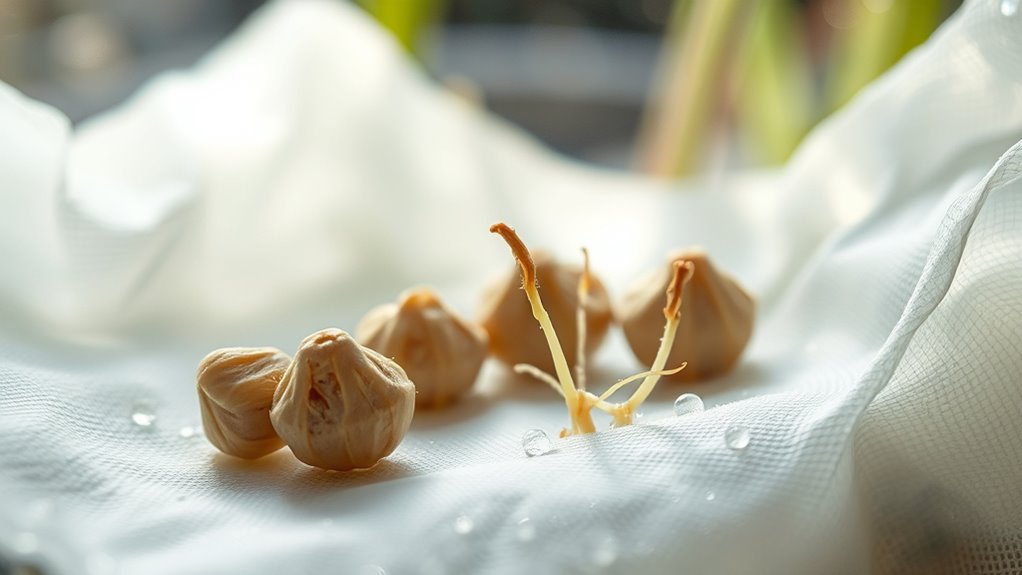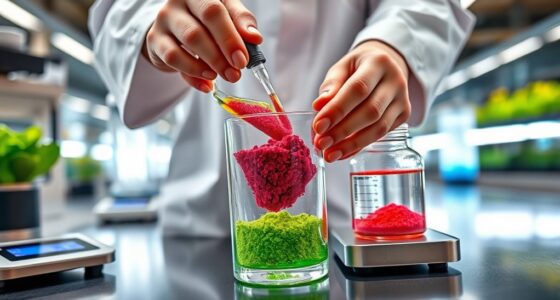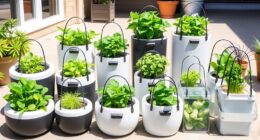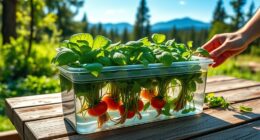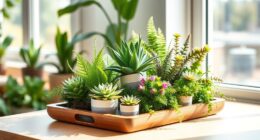To boost germination in hydroponics, start by selecting fresh, high-quality seeds stored in a cool, dry place. Soak them in lukewarm water for 12-24 hours to soften the seed coats, then place them on moist paper towels or media in a warm, humid environment. Keep humidity high and avoid direct light, maintaining steady temperatures. Properly managing these steps will give your seeds a strong start—and there’s much more to optimize this process effectively.
Key Takeaways
- Use high-quality, fresh seeds with intact seed coats stored in a cool, dry, airtight environment for better germination.
- Soak seeds in lukewarm water for 12-24 hours to soften seed coats and promote faster sprouting.
- Maintain humidity around 70-80% with covers or domes, and provide indirect light to create optimal sprouting conditions.
- Keep temperature steady between 65-75°F and monitor moisture levels to prevent mold and over-drying.
- Support seedling growth with proper nutrition, environmental stability, and early root development management.
Selecting the Right Seeds and Preparing Them for Germination

Choosing the right seeds is essential for successful hydroponic germination. Before planting, check how you store your seeds. Proper seed storage preserves seed viability, ensuring they stay healthy and capable of sprouting. Keep seeds in a cool, dry place, away from direct sunlight, and in airtight containers to prevent moisture damage. When selecting seeds, look for high-quality, fresh options with intact seed coats, as these are more likely to germinate successfully. Avoid using old or damaged seeds, which have lower viability and can hinder your hydroponic setup. By carefully managing seed storage and choosing viable seeds, you boost your chances of a strong, healthy start for your plants. This foundation is key to a thriving hydroponic garden.
Optimal Soaking and Pre-Germination Techniques

To maximize germination success, proper soaking and pre-germination techniques are essential. Start by ensuring your seeds are viable; fresh seeds tend to have higher germination rates. Soak the seeds in lukewarm water for 12-24 hours, which helps soften the seed coat and jump-start germination. Use a clean container to prevent mold or bacterial growth. After soaking, place the seeds on a moist paper towel or in a seed-starting medium, keeping them warm and humid. This pre-germination step aligns germination timing, reducing delays and encouraging uniform sprouting. Avoid over-soaking, as it can lead to seed rot. Consistent moisture and temperature are key for maintaining seed viability and ensuring a swift, successful germination process. Additionally, understanding projector contrast ratios can help optimize your viewing environment for better observation of seed development.
Creating the Perfect Environment for Sprouting
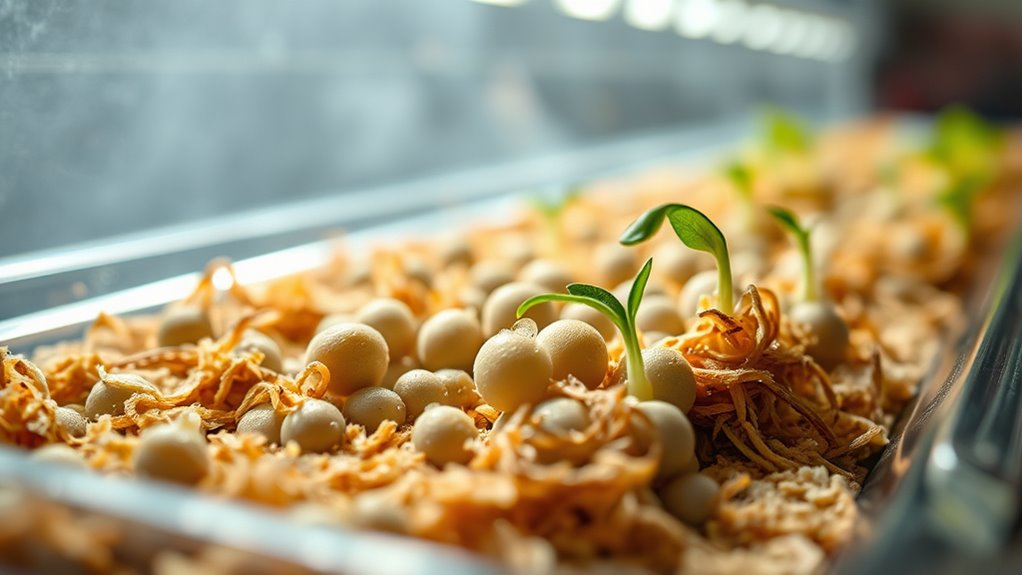
Creating the ideal environment for sprouting is crucial to guarantee quick and uniform germination. Start by controlling humidity; maintain it around 70-80% to prevent drying out or excess moisture that can cause mold. Use a humidity dome or plastic cover to keep conditions stable during the initial stages. Light management is equally important—provide indirect light or a gentle, low-intensity source to avoid stressing delicate seedlings. Avoid direct sunlight, which can overheat or dry out the environment. Keep the temperature steady between 65-75°F to support healthy sprouting. Regularly check humidity levels and light exposure, adjusting as needed to ensure the best conditions. Proper nutritional support is essential once seedlings begin to develop, helping them grow strong and healthy. With proper humidity control and light management, your seedlings will sprout evenly and develop strong roots.
Troubleshooting Common Germination Challenges
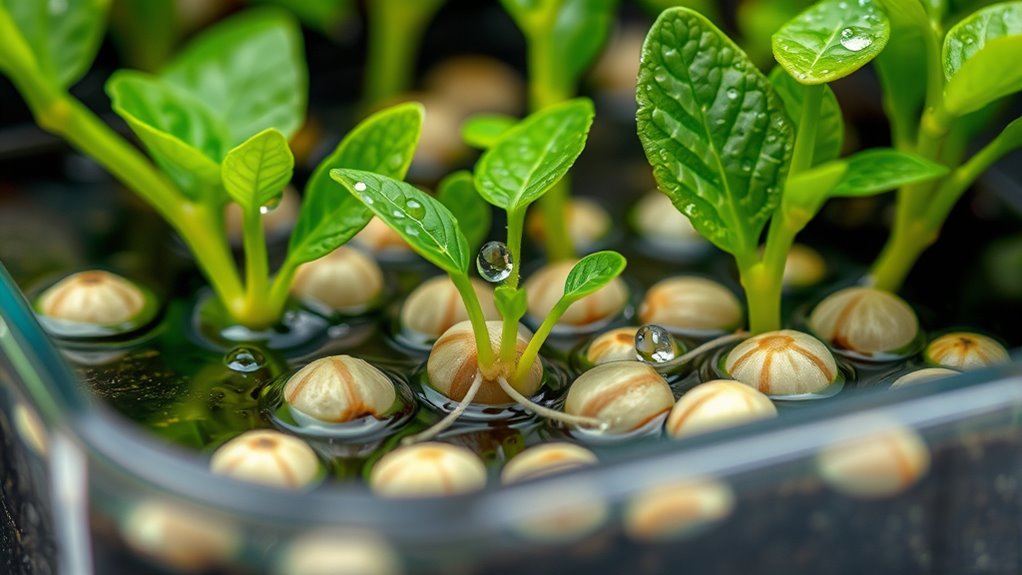
Even when you’ve set up the perfect environment, germination problems can still occur. One common issue is seed dormancy, where seeds won’t sprout despite ideal conditions. To overcome this, you might need to break dormancy through pre-treatments like soaking or scarification. Additionally, low genetic diversity can cause inconsistent results; using a diverse seed batch guarantees better germination rates and healthier plants. Sometimes, seeds are inherently slow to germinate or fail altogether due to genetic factors or physiological barriers. Keep in mind that not all seeds are viable, so performing a germination test before planting helps identify weak or dead seeds. Adjust your approach based on these challenges, and always make sure your seeds are fresh and properly stored to maximize germination success.
Frequently Asked Questions
How Long Does Seed Germination Typically Take in Hydroponics?
The growth timeline for seed germination in hydroponics usually takes between 3 to 7 days, but it varies based on environmental factors like temperature, humidity, and light. You should keep conditions consistent and monitor moisture levels closely. If you provide ideal conditions, you’ll see sprouting happen quicker. Remember, patience is key, and maintaining stable environmental factors helps guarantee a smooth and successful germination process.
Can I Use Any Seed Type for Hydroponic Germination?
You can use many seed types for hydroponic germination, but seed compatibility varies. Some seeds germinate faster and better in hydroponic setups, while others may need specific seed treatment methods like soaking or sterilization. Always check seed compatibility before planting, and prepare seeds properly to boost success rates. Using the right seeds and treatment methods guarantees healthier sprouts and a more productive hydroponic system.
What Are the Signs of Successful Seed Sprouting?
Imagine you’ve just planted your hydroponic seeds and wait eagerly. Signs of successful sprouting include tiny green shoots emerging from the medium, showing strong sprout vigor. You’ll notice healthy seedling health with firm stems and vibrant leaves. If your seeds sprout within the expected timeframe and grow steadily without discoloration or wilting, your germination is successful. These signs confirm your seedling’s vitality and readiness to thrive in your hydroponic system.
How Often Should I Check on Germinating Seeds?
You should check on your germinating seeds daily to guarantee proper seedling maintenance and environmental monitoring. Regular checks help you catch issues like mold, drying out, or overwatering early. Gently observe the moisture levels, temperature, and light exposure to keep conditions ideal. Consistent monitoring encourages healthy sprouting and prevents problems from developing, so make it a habit to inspect your seeds without overhandling them.
Is It Necessary to Use Sterile Water for Soaking Seeds?
You don’t need sterile water for soaking seeds, but using pure water helps prevent infections. Seed sterilization isn’t always necessary, especially if your seeds are healthy. If you choose to sterilize, verify water purity to avoid introducing harmful bacteria or fungi. Regularly check your seeds during germination, and maintain clean conditions. This approach increases your chances of successful sprouting while keeping the process simple and effective.
Conclusion
With a little patience and attention, you’ll find your seeds blossoming into vibrant life. Every step you take in preparing and nurturing them is like gentle encouragement, guiding them toward their full potential. Trust in the process, even when faced with quiet setbacks, knowing that your care is gently shaping a lush, thriving future. Soon, your hydroponic garden will bloom with the promise of growth—proof that perseverance and love truly make miracles happen.
